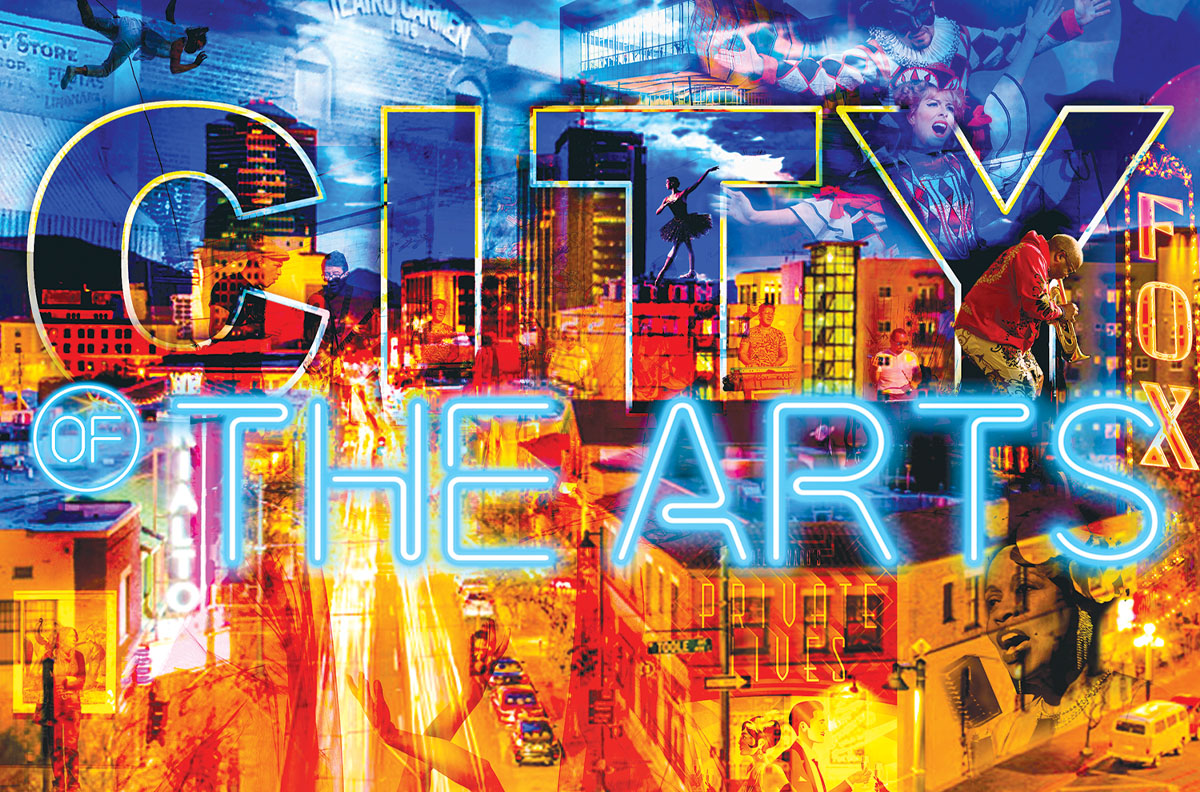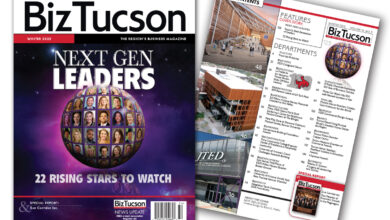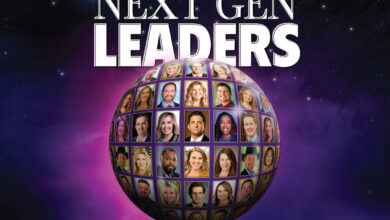
Tucson Flourishes as Arts Mecca
By Loni Nannini
Renowned as the “Old Pueblo,” Tucson has evolved into a 21st-century destination for the visual and performing arts.
More than 2,600 arts organizations, nonprofits and businesses in Southern Arizona form the creative infrastructure that drives civic, cultural, economic, educational and social influence across the region.
The Arts: An Economic Powerhouse
Statewide, the rich tapestry of traditional, Indigenous, contemporary and emerging forms of arts and culture account for more than 86,000 jobs and contribute $9.6 billion to the economy annually, according to 2020 statistics from the U.S. Bureau of Economic Analysis. In 2021, Southern Methodist University DataArts (which partners with local arts organizations nationwide) found that 37 Tucson arts organizations – 36 with budgets under $5 million – generated more than $34 million in salaries and benefits to local residents and physical expenses (rent and repairs) paid to local businesses.
In Southern Arizona, this translates into real dollars for dining, lodging, retail and industries such as architecture, construction, commercial real estate, technology, industrial and interior design services. A 2020 study by the Southern Arizona Arts and Cultural Alliance revealed the nonprofit arts and cultural sector generates 10,000-plus jobs and $87.7 million in annual revenue.
“Prior to the COVID pandemic, statistics indicated that for every dollar spent attending a performance, an additional $5 to $7 dollars are generated in the local economy. We can tell you what is happening on all of the stages in Tucson, but as an industry, we must promote awareness about the economic impact of these performances,” said Chad Herzog, executive director of Arizona Arts Live.
The importance of Tucson’s diverse arts to economic sustainability can’t be overstated, said Michael Guymon, president and CEO of the Tucson Metro Chamber.
“All economically viable and successful communities have an abundant arts scene and Tucson is distinguished by offering every element of performance art: music, opera, dance, drama and vocal arts,” said Guymon. “We also have a vibrant visual arts scene with venues like the Tucson Museum of Art and the Museum of Contemporary Art, where I previously served on the board of directors. We also have incredible murals, public art and other amenities typically found in major cities like Chicago, Los Angeles and New York.”
That profile is enhanced by safe housing and neighborhoods, education, health services and more that create “Livable Communities.” They result in a competitive edge over other cities as determined by the Economic Blueprint created in conjunction with Sun Corridor Inc., the region’s economic development arm.
“Our original economic blueprint, which was developed 15 years ago and is still our guidepost today, notes that economically competitive communities have high standards for livability. We identified a vibrant arts and culture community as one of those standards,” said Joe Snell, Sun Corridor Inc. president and CEO.
Long-Term Investment Pays Dividends
The success of the arts is vital to the community, said I. Michael Kasser, founder and chairman of Holualoa Companies. Kasser and his wife, Beth, are patrons of Arizona Theatre Company, Arizona Opera and the Tucson Symphony Orchestra. They contribute extensively to the pre-Columbian collection at the Tucson Museum of Art.
“Tucson offers the five biggies – ballet, opera, theatre, music and visual arts – and many people considering a job offer or thinking about moving to Tucson want to make sure the city has these qualities for them and their children,” said Kasser.
The arts factor into the quality of life that attracts employees and businesses, said Lisa Lovallo, market VP of Cox Communications and member of the Sun Corridor Inc. Chairman’s Circle.
Tucson’s commitment to the arts is routinely pitched to prospective employers, Lovallo said. “Our region competes for talent from around the world. The arts play a vital role in selling Tucson to prospective employers and employees alike.”
Over the past decade, communities across Arizona have increasingly recognized the short- and long-term value of investing in the arts, said Kate Marquez, executive director of SAACA and founder of CATALYST Collaborative Arts & Maker Space. SAACA advocates for increased permanent arts funding through city, county and state governments.
“Communities have identified that investments in the arts are investments in tourism, hospitality and other industries while helping to build a stronger sense of self and place,” Marquez said.
Collaboration for Conscientious Growth
This value of arts as infrastructure is heralded by the Arts Foundation of Tucson and Southern Arizona, an agency that stewards funding for artists, arts workers, arts organizations and public art.
From July 2020 through June 2022, the foundation distributed nearly $2.5 million to 500-plus artists and arts organizations here. The funding was provided by the City of Tucson, the Coronavirus Aid, Relief, and Economic Security Act, and the National Endowment for the Arts, along with Pima County and Arizona Commission on the Arts. It was funneled to artists and affiliate workers who lost an average of $10,000 in annual revenue, resulting in a loss of $25 million annually during the pandemic, said Adriana Gallego, executive director of the Arts Foundation for Tucson and Southern Arizona.
The Governor’s Office also recently awarded $750,000 to the region’s four leading performing arts organizations – Arizona Opera, Arizona Theatre Company, Ballet Tucson, and the TSO – to provide support in the pandemic’s wake.
“There has been a resurgence of audiences, but not to pre-pandemic levels,” Gallego said. “It will take time to understand the true impact and opportunities that have resulted from the pandemic. In general, artists and organizations who reconnect to their communities, revisit the core values of their missions, stay agile and correct any systemic inequities are able to bounce back faster.”
A post-pandemic plan for Relief, Recovery and Rebuilding will move into its final phase this year. Creative problem-solving, collaboration and reassessment form the plan’s core, along with expanded relationships with the public and private sectors.
“We know that artists spend tens of thousands of hours thinking outside the box and we want to make sure that kind of thinking reaches all sectors of society,” Gallego said.





